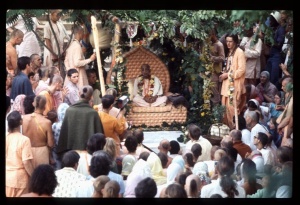CC Madhya 24.277 (1975): Difference between revisions
(Vanibot #0027: CCMirror - Mirror CC's 1996 edition to form a basis for 1975) |
(Vanibot #0020: VersionCompareLinker - added a link to the Version Compare feature) |
||
| Line 2: | Line 2: | ||
<div style="float:left">'''[[Sri Caitanya-caritamrta (1975)|Śrī Caitanya-caritāmṛta (1975)]] - [[CC Madhya (1975)|Madhya-līlā]] - [[CC Madhya 24 (1975)|Chapter 24: The Sixty-One Explanations of the Atmārāma Verse]]'''</div> | <div style="float:left">'''[[Sri Caitanya-caritamrta (1975)|Śrī Caitanya-caritāmṛta (1975)]] - [[CC Madhya (1975)|Madhya-līlā]] - [[CC Madhya 24 (1975)|Chapter 24: The Sixty-One Explanations of the Atmārāma Verse]]'''</div> | ||
<div style="float:right">[[File:Go-previous.png|link=CC Madhya 24.276 (1975)|Madhya-līlā 24.276]] '''[[CC Madhya 24.276 (1975)|Madhya-līlā 24.276]] - [[CC Madhya 24.278 (1975)|Madhya-līlā 24.278]]''' [[File:Go-next.png|link=CC Madhya 24.278 (1975)|Madhya-līlā 24.278]]</div> | <div style="float:right">[[File:Go-previous.png|link=CC Madhya 24.276 (1975)|Madhya-līlā 24.276]] '''[[CC Madhya 24.276 (1975)|Madhya-līlā 24.276]] - [[CC Madhya 24.278 (1975)|Madhya-līlā 24.278]]''' [[File:Go-next.png|link=CC Madhya 24.278 (1975)|Madhya-līlā 24.278]]</div> | ||
{{CompareVersions|CC|Madhya 24.277|CC 1975|CC 1996}} | |||
{{RandomImage}} | {{RandomImage}} | ||
==== TEXT 277 ==== | ==== TEXT 277 ==== | ||
| Line 11: | Line 10: | ||
<div class="verse"> | <div class="verse"> | ||
:dekhiyā vyādhera prema parvata-mahāmuni | :dekhiyā vyādhera prema parvata-mahāmuni | ||
:nāradere kahe, | :nāradere kahe,--tumi hao sparśa-maṇi | ||
</div> | </div> | ||
| Line 25: | Line 24: | ||
<div class="translation"> | <div class="translation"> | ||
"When Parvata Muni saw the ecstatic loving symptoms of the hunter, he told Nārada, 'Certainly you are a touchstone.' | |||
</div> | </div> | ||
| Line 32: | Line 31: | ||
<div class="purport"> | <div class="purport"> | ||
When a touchstone touches iron, it turns the iron to gold. Parvata Muni called Nārada Muni a touchstone because by his touch the hunter, who was | When a touchstone touches iron, it turns the iron to gold. Parvata Muni called Nārada Muni a touchstone because by his touch the hunter, who was lowest among men, became an elevated and perfect Vaiṣṇava. Śrīla Bhaktivinoda Ṭhākura said that the position of a Vaiṣṇava can be tested by seeing how good a touchstone he is-that is, by seeing how many Vaiṣṇavas he has made during his life. A Vaiṣṇava should be a touchstone so that he can convert others to Vaiṣṇavism by his preaching, even though people may be fallen like the hunter. There are many so-called advanced devotees who sit in a secluded place for their personal benefit. They do not go out to preach and convert others into Vaiṣṇavas, and therefore they certainly cannot be called sparśa-maṇi, advanced devotees. Kaniṣṭha-adhikārī devotees cannot turn others into Vaiṣṇavas, but a madhyama-adhikārī Vaiṣṇava can do so by preaching. Śrī Caitanya Mahāprabhu advised His followers to increase the numbers of Vaiṣṇavas. | ||
It is Śrī Caitanya | :yāre dekha, tāre kaha 'kṛṣṇa'-upadeśa | ||
:āmāra ājñāya guru hañā tāra' ei deśa | |||
([[CC Madhya 7.128]]) | |||
It is Śrī Caitanya Mahāprabhu's wish that everyone should become a Vaiṣṇava and guru. Following the instructions of Śrī Caitanya Mahāprabhu and His disciplic succession, one can become a spiritual master, for the process is very easy. One can go everywhere and anywhere to preach the instructions of Kṛṣṇa. Bhagavad-gītā is Kṛṣṇa's instructions; therefore the duty of every Vaiṣṇava is to travel and preach Bhagavad-gītā, either in his country or a foreign country. This is the test of sparśa-maṇi, following in the footsteps of Nārada Muni. | |||
</div> | </div> | ||
Latest revision as of 15:34, 27 January 2020

A.C. Bhaktivedanta Swami Prabhupada
TEXT 277
- dekhiyā vyādhera prema parvata-mahāmuni
- nāradere kahe,--tumi hao sparśa-maṇi
SYNONYMS
dekhiyā—seeing; vyādhera—of the hunter; prema—the ecstatic love; parvata-mahā-muni—the great sage Parvata Muni; nāradere kahe—spoke to Nārada Muni; tumi hao sparśa-maṇi—you are certainly a touchstone.
TRANSLATION
"When Parvata Muni saw the ecstatic loving symptoms of the hunter, he told Nārada, 'Certainly you are a touchstone.'
PURPORT
When a touchstone touches iron, it turns the iron to gold. Parvata Muni called Nārada Muni a touchstone because by his touch the hunter, who was lowest among men, became an elevated and perfect Vaiṣṇava. Śrīla Bhaktivinoda Ṭhākura said that the position of a Vaiṣṇava can be tested by seeing how good a touchstone he is-that is, by seeing how many Vaiṣṇavas he has made during his life. A Vaiṣṇava should be a touchstone so that he can convert others to Vaiṣṇavism by his preaching, even though people may be fallen like the hunter. There are many so-called advanced devotees who sit in a secluded place for their personal benefit. They do not go out to preach and convert others into Vaiṣṇavas, and therefore they certainly cannot be called sparśa-maṇi, advanced devotees. Kaniṣṭha-adhikārī devotees cannot turn others into Vaiṣṇavas, but a madhyama-adhikārī Vaiṣṇava can do so by preaching. Śrī Caitanya Mahāprabhu advised His followers to increase the numbers of Vaiṣṇavas.
- yāre dekha, tāre kaha 'kṛṣṇa'-upadeśa
- āmāra ājñāya guru hañā tāra' ei deśa
(CC Madhya 7.128) It is Śrī Caitanya Mahāprabhu's wish that everyone should become a Vaiṣṇava and guru. Following the instructions of Śrī Caitanya Mahāprabhu and His disciplic succession, one can become a spiritual master, for the process is very easy. One can go everywhere and anywhere to preach the instructions of Kṛṣṇa. Bhagavad-gītā is Kṛṣṇa's instructions; therefore the duty of every Vaiṣṇava is to travel and preach Bhagavad-gītā, either in his country or a foreign country. This is the test of sparśa-maṇi, following in the footsteps of Nārada Muni.